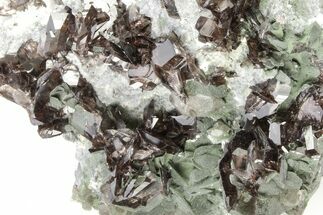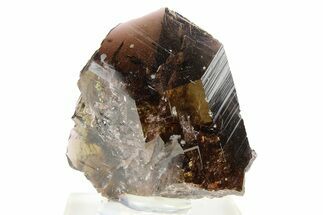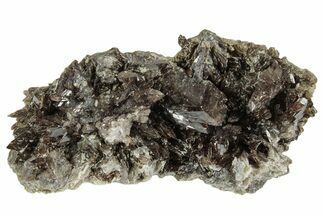This Specimen has been sold.
1.9" Axinite & Epidote Crystal Cluster - Peru
This is an axinite crystal cluster that was collected from the Canta Province of Peru. There is an association of green epidote crystals.
About Epidote
Epidote is a striking and often green mineral known for its complex crystal structure and vitreous luster. It is a calcium aluminum iron silicate that commonly forms in metamorphic rocks, particularly in regions that have undergone low to medium-grade metamorphism. The color of epidote typically ranges from pistachio green to dark green, although it can occasionally appear yellowish-green or even brown due to varying iron content.
Epidote crystals can appear in prismatic, slender forms or as aggregates, and they often exhibit striations along their length. The mineral’s translucent to transparent appearance and high refractive index give it an attractive, glassy shine.
It is commonly associated with minerals such as quartz, feldspar, and garnet, often forming in metamorphic rocks like schist and gneiss. It can also be found in skarn deposits alongside minerals like calcite, diopside, and amphiboles. These associations can provide insights into the geologic history and metamorphic conditions of the region. Epidote is found in locations worldwide, with notable sources including Austria, Norway, Pakistan, and parts of the United States. Collectors prize epidote for its unique green hues and well-formed crystal clusters.
Epidote is a striking and often green mineral known for its complex crystal structure and vitreous luster. It is a calcium aluminum iron silicate that commonly forms in metamorphic rocks, particularly in regions that have undergone low to medium-grade metamorphism. The color of epidote typically ranges from pistachio green to dark green, although it can occasionally appear yellowish-green or even brown due to varying iron content.
Epidote crystals can appear in prismatic, slender forms or as aggregates, and they often exhibit striations along their length. The mineral’s translucent to transparent appearance and high refractive index give it an attractive, glassy shine.
It is commonly associated with minerals such as quartz, feldspar, and garnet, often forming in metamorphic rocks like schist and gneiss. It can also be found in skarn deposits alongside minerals like calcite, diopside, and amphiboles. These associations can provide insights into the geologic history and metamorphic conditions of the region. Epidote is found in locations worldwide, with notable sources including Austria, Norway, Pakistan, and parts of the United States. Collectors prize epidote for its unique green hues and well-formed crystal clusters.
Axinite is a subgroup under the silicate group of minerals, with three possible mineral compositions. The inclusive formula, encompassing all possible mineral member combinations, is (Ca,Fe,Mg,Mn)3Al2BSi4O15(OH). The presence of one listed alkaline or transitional element will effect the structure and colors displayed by the axinite crystal. It typically forms thin, sharp triclinic crystals, with colors ranging anywhere from a light yellow-brown to various shades of blue and green. The group name is derived from the Greek word 'axina', meaning axe, to describe the group's bladed crystal habit.
SPECIES
Axinite & Epidote
LOCATION
Canta, Canta Province, Lima Department, Peru
SIZE
1.9" long, 1.3" tall
CATEGORY
ITEM
#99666
 Reviews
Reviews













